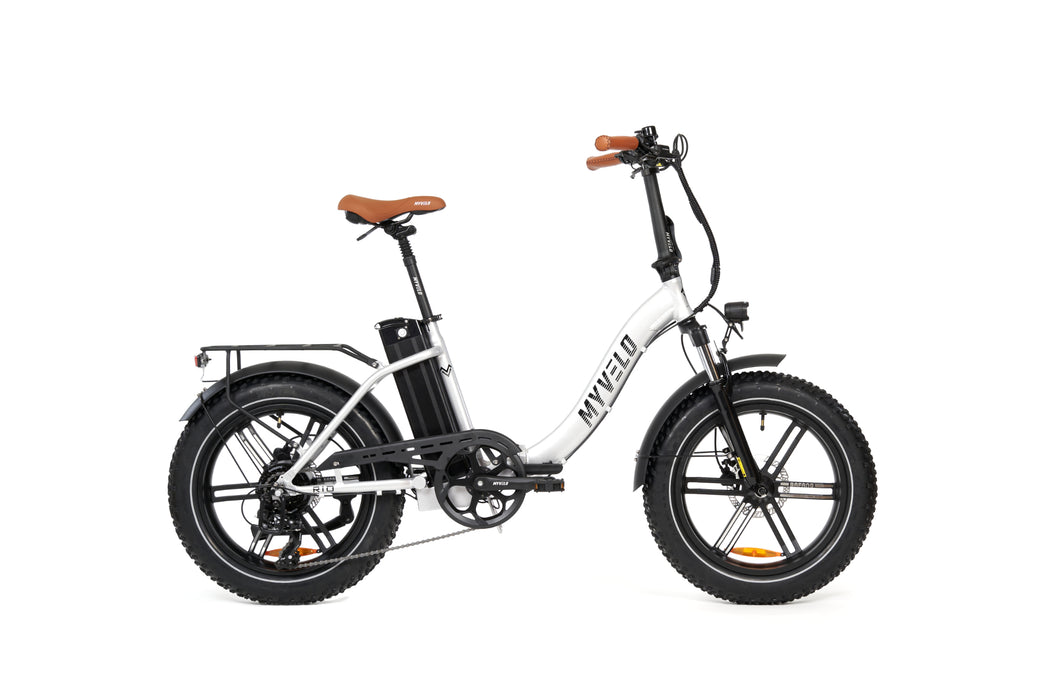
Rio electric folding bike
incl. FREE shipping & free returns
Ready for dispatch immediately, delivery time 2-3 days.

The freewheel is a mechanism on the rear hub of a bicycle that allows the cyclist to rest the pedals in certain situations without the crank and thus the rear wheel turning. The freewheel helps make cycling more efficient and comfortable.
The freewheel consists of a pinion gear mounted on the rear hub and a freewheel clutch. This clutch allows the pinion gear to rotate with the hub in one direction (usually forward) while rotating freely in the other direction. This means that the pedals are only connected to the crank and pinion gear when the rider is pedaling and moving the bike forward.
Situations in which the freewheel is particularly useful are, for example, when riding downhill or when the bike is rolling faster than the rider's pedaling speed. In these moments, the rider can rest the pedals without the crank turning. This increases riding comfort and allows the cyclist to better concentrate on the stability and control of the bike.
The freewheel is now a standard component of almost all bicycles with derailleur gears .

Entdecke den MYVELO
Entdecke Dein Traum E-Bike im MYVELO Onlineshop. Direkt vom Hersteller Dein Fahrrad aussuchen.

Dein Traumrad
MYVELO hat bereits 2 Standorte: Oberkirch & Geretsried. Komm in unsere Flagship Stores und probiere Dein Traum Bike aus. Lass Dich von uns zu Deinen Anforderungen beraten.

Leasen statt kaufen
Spare mit Leasing! Finanziere Dein Traum E-Bike ganz einfach über Deinen Arbeitgeber. MYVELO unterstützt Dich im Leasing-Prozess bei Deinen Fragen.

Das Kettenblatt ist ein zentrales Bauteil am E-Bike, das oft unterschätzt wird. Gerade bei E-Bikes mit Mittelmotoren hat die Wahl des Kettenblatts großen Einfluss auf die Übersetzung, das Tretgefühl und die Effizienz des Motors. In diesem Artikel erklären wir, worauf man achten sollte und welche Unterschiede verschiedene Kettenblattgrößen machen.

Eine gute Beleuchtung gehört zu den wichtigsten Sicherheitsfeatures eines E-Bikes. Doch wer viel pendelt, in der Dämmerung fährt oder regelmäßig längere Touren unternimmt, merkt schnell: Fahrradlicht ist nicht gleich Fahrradlicht. Zwischen „gut“ und „sehr gut“ liegen oft Welten – besonders, wenn man die höheren Geschwindigkeiten und längeren Einsatzzeiten eines E-Bikes berücksichtigt.

Wer sich den Traum vom hochwertigen E-Bike erfüllen möchte, steht oft vor einer großen Investition. Doch immer mehr Menschen entdecken eine clevere Alternative zum Kauf: das Fahrrad privat leasen. Was bisher vor allem im Jobrad-Modell über Arbeitgeber bekannt war, funktioniert heute auch für Privatpersonen – flexibel, günstig und steuerlich oft vorteilhaft.